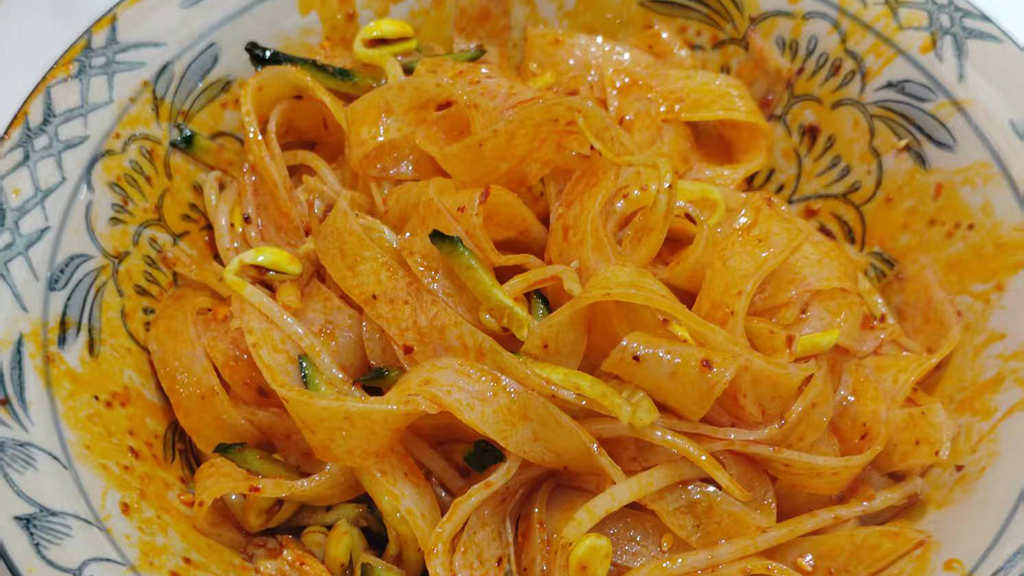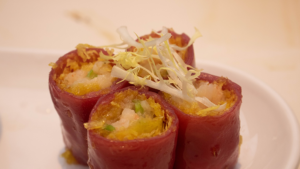If you ever visit Xi’an, you’ll quickly notice that Ganmianpi is a local favorite. It might not be as famous as liangpi, roujiamo, or biang biang noodles, but trust me—once you try it, you won’t forget it. This chewy, spicy, and slightly sour snack comes from Baoji, a city in Shaanxi Province, and has become a staple across the region. People in Baoji love it just like folks in Chongqing love hot pot. The key to its deliciousness? A thick, chewy texture paired with a fiery vinegar-based sauce that makes every bite addictive.
A Tasty Accident: How Ganmianpi Was Born
Legend has it that this dish started with a Shaanxi farmer during the Tang Dynasty. He needed an easy-to-carry meal for long farming days, so he rolled out dough into thin sheets, steamed them, and cut them into strips. With a few simple seasonings, he had a filling and flavorful meal. Over time, people refined the recipe, turning it into the famous rolled noodle skin you see today. Whether this story is true or not, it sure makes the dish even more legendary!
What Makes the Perfect Ganmianpi?
The secret starts with the right flour. High-gluten flour is a must because it gives the noodles their signature chewiness. With over 12% protein, it creates that firm, bouncy bite that sets rolled noodle skin apart from liangpi. The process isn’t easy—mixing, kneading, rolling, and steaming all require skill. Experienced chefs know exactly how to control the heat and texture to get that perfect balance between softness and chew.
Different Types, Same Great Taste
You might think rolled noodle skin is a one-style-fits-all snack, but there are actually a few variations:
- Hand-Rolled: The classic version, made by hand for the best chewy texture and bold spicy-sour kick.
- Machine-Rolled: A softer version, great for those who prefer a smoother bite.
- Steamed: Extra soft and easier to digest, making it perfect for those with sensitive stomachs.
No matter which one you try, you’ll get that signature flavor explosion in every bite.
What Makes It So Addictive?
Ganmianpi is all about the balance of flavors and textures. The vinegar gives it a tangy kick, the chili oil adds heat, and the dough itself is thick and satisfying to chew. But what really takes it to the next level is the mix of toppings:
- Shredded cucumber – Crisp and refreshing to balance out the heat.
- Bean sprouts – Add crunch and extra nutrients.
- Gluten pieces – Soak up all the delicious sauce for an extra burst of flavor.
- Cilantro & garlic paste – Bring out the aroma and round off the taste.
These ingredients don’t just add texture—they make the dish more nutritious and well-balanced, so you can enjoy it guilt-free.
Ganmianpi vs. Liangpi: What’s the Difference?
It’s easy to mix them up, but rolled noodle skin and liangpi are totally different. Here’s how you can tell:
Texture: Ganmianpi is thick, chewy, and firm, while liangpi is soft and almost melts in your mouth.
How It’s Made: Ganmianpi is made by rolling and steaming dough, while liangpi comes from washing flour to extract starch.
Flavor: Ganmianpi leans into bold, spicy, and sour flavors. Liangpi is milder, often with a sesame-based sauce.
Appearance: Ganmianpi is thicker and paler, while liangpi is thinner and more translucent.
Think of rolled noodle skin as the “tough guy” of the two—bold, chewy, and packed with intense flavor—while liangpi is the “gentle one,” soft and refreshing.
Can You Eat It Without Gaining Weight?
Ganmianpi is made from flour, so yes, it’s high in carbs. A typical serving (about 200g) has around 300-400 calories, depending on how much oil and vinegar you add. The good news? It’s usually served with fresh veggies, so it’s more balanced than it seems. If you’re watching your calories, just go easy on the chili oil and vinegar or load up on the cucumbers and bean sprouts.
Final Thoughts: Don’t Leave Shaanxi Without Trying It!
If you ever find yourself in Shaanxi, do yourself a favor and grab a bowl of Ganmianpi. The chewy texture, spicy kick, and tangy vinegar sauce create a flavor experience you won’t forget. It’s a taste of local culture—one that’s been perfected over generations and loved by anyone who tries it. Ready to give it a go?


